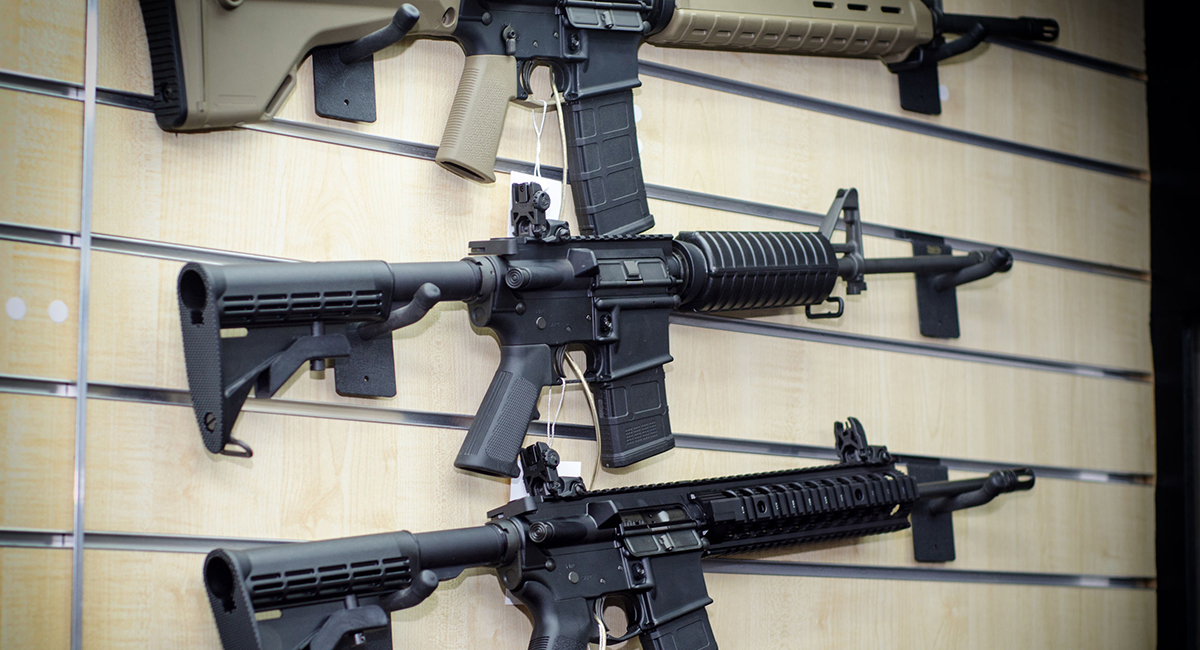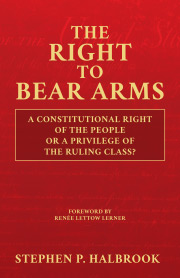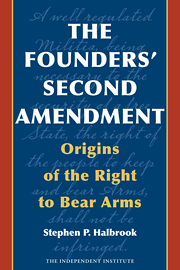The latest salvo in America’s “assault-weapon” wars is the decision of February 17 by Judge Virginia Kendall of the Norther District of Illinois in Bevis v. City of Naperville finding that plaintiffs are not likely to prevail on their challenge to the bans under the city’s ordinance or under Illinois’ just-passed Protect Illinois Communities Act.
Just last year in New York State Rifle & Pistol Ass’n v. Bruen, the Supreme Court said that “the Second Amendment extends, prima facie, to all instruments that constitute bearable arms,” and that the term “arms” “covers modern instruments that facilitate armed self-defense” and “weapons that are unquestionably in common use today.” None of those three phrases found its way into the district court’s decision approving the prohibition of the AR-15, America’s most popular rifle, and many other semiautomatics.
The court started out on the right track recognizing that the plaintiffs had standing and that the harm they sought to alleviate was redressable. It made the interesting point that the Second Amendment “differs from many other amendments in that it protects access to a tangible item, as opposed to an intangible right,” and that makes it similar to the First Amendment, under which “individuals can sue when the government bans protected books or attempts to close a bookstore based on content censorship.”
While five appellate courts had upheld “assault weapon” bans, Bruen pulled the rug out from under them with its text-history approach and rejection of the two-part balancing test. The Seventh Circuit had gone its own way in Friedman v. City of Highland Park (2015), holding that the banned arms were not common at the time of ratification, had no militia nexus, and were not needed by citizens for self-defense. As Judge Kendall wrote, “Friedman cannot be reconciled with Bruen.” Per Bruen, protected arms are not limited to those that existed in 1791 or that are useful in warfare, and “the arguments that other weapons are available and that fewer assault weapons lower the risk of violence are tied to means-end scrutiny—now impermissible and unconnected to text, history, and tradition.”
So far so good, but that’s where the opinion goes awry. It states: “The text of the Second Amendment is limited to only certain arms, and history and tradition demonstrate that particularly ’dangerous’ weapons are unprotected.” For that it cites Heller at 627, but on that page Heller said that the Amendment protects arms that are “in common use at the time,” which is a limitation “fairly supported by the historical tradition of prohibiting the carrying of ’dangerous and unusual weapons.’”
For that proposition, Heller cited a dozen historical sources, only one of which substituted “or” for “and”—Blackstone referred to going armed with “with dangerous or unusual weapons.” But Bevis read too much into that conjunction. Bruen repeated the basic distinction between arms that are “in common use” and those that are “dangerous and unusual.” The Court in Staples v. US (1994) made a similar distinction between machine guns and commonly-possessed arms like the AR-15, noting that the latter are no different than cars in potentially being dangerous. And in Caetano v. Massachusetts (2016), Justice Alito wrote that “this is a conjunctive test: A weapon may not be banned unless it is both dangerous and unusual.”
So Bevis begins with the fundamentally wrong criterion that being particularly “dangerous,” alone, justifies banning a type of firearm.
The court goes on to justify the ban under a historical test, arguing that, unlike today, gun restrictions weren’t needed at the founding: “In the 18th century, violent crime was at historic lows; the rate at which adult colonists were killed by violent crime was one per 100,000 in New England and, on the high end, five per 100,000 in Tidewater, Virginia.” For that the court cites Randolph Roth, American Homicide 61–63 (2009). But as that book says, those were the rates “between the mid-1670s and the mid-1690s,” the low rate ended in “the revolutionary crisis of the 1760s and 1770s,” and “the extremely high homicide rates persisted until the end of the War of 1812 ....”
In arguing that guns were not a problem at the founding, the court describes muskets as being slow and fairly useless, and that “only a small group of wealthy, elite men owned pistols, primarily a dueling weapon.” This history is starting to read like Michael Bellesiles discredited Arming America. As I’ve shown in The Founders’ Second Amendment, long guns and pistols alike were in common use. For instance, just after Lexington and Concord, British General Thomas Gage confiscated 1,778 long guns and 634 pistols from the citizens of Boston.
Since there were no gun bans at the founding, the Bevis court turns to Bowie knives, citing restrictions in a minority of states in the antebellum period that focused mostly on banning concealed carry. An 1837 Georgia law made it unlawful for a merchant to sell a Bowie knife or to carry such knife or a pistol about the person, and Bevis states that “State-court decisions uniformly upheld these laws.” Not so. In Nunn v. State (1846), the Georgia Supreme Court held that the law violated the right to bear arms to the extent it prohibited open carry.
Nunn called the law an “absurdity” because it banned the sale and keeping of Bowie knives, pistols, and spears (!), but then exempted those who “openly wear” such arms. It then stated: “The right of the whole people, old and young, men, women and boys, and not militia only, to keep and bear arms of every description, and not such merely as are used by the militia, shall not be infringed, curtailed, or broken in upon, in the smallest degree ....”
Bevis next cites Aymette v. State (1840), in which the Tennessee Supreme Court affirmed a conviction for concealed carry, but upheld the right openly to carry swords, muskets, and rifles. Not exactly a precedent for banning such arms. And it cited the Texas Supreme Court decision in Cockrum v. State (1859), which upheld a law with enhanced punishment for murder using a Bowie knife, but added: “The right of a citizen to bear arms, in the lawful defense of himself or the state, is absolute.”
Bans on trap-guns set to discharge by tripping a cord are next cited by Bevis, but the guns themselves were not banned, just the dangerous practice. The next cited precedents were Prohibition-era bans on arms with certain firing capacities, but most referred to discharge “by a single pressure upon the trigger device,” i.e., machine guns, not semiautomatics.
The Illinois ban not having a basis in Bruen’s text-history approach, Bevis resorts to the disapproved means-ends scrutiny to show: “Assaults weapons pose an exceptional danger, more so than standard self-defense weapons such as handguns.” While “they fire quickly,” so can handguns.
The most puzzling statement of Bevis comes next: “The muzzle velocity of an assault weapon is four times higher than a high-powered semiautomatic firearm.” Moreover, the “injury along the path of the bullet from an AR-15 is vastly different from a low-velocity handgun injury ....” But now the court is comparing, depending on the cartridge type, all rifles with all handguns. No difference exists between the muzzle velocity of an “assault weapon” and any other rifle with the same cartridge and barrel length. While most AR-15s fire the .223 caliber cartridge, deer hunting rifles generally fire far more powerful rounds.
The Bevis court does not articulate any of the defined features of an “assault weapon” that make it so dangerous that it must be banned. Other than quoting the statute, it doesn’t even mention them. “A pistol grip.” And that makes it too powerful? A telescoping stock that makes it adjustable to the user. That makes it fire faster? Go down the checklist of verboten features. None have anything to do with the alleged ability to obliterate a victim.
We are left with who-knows-who’s definition of “assault weapon” as the court claims: “While a high number of assault weapons are in circulation, only 5 percent of firearms are assault weapons, 24 million out of an estimated 462 million firearms.” Avoiding Heller’s test that arms in common use by law-abiding citizens for lawful purposes are protected, the court assets that “just under 45 percent of all gang members own an assault rifle (compared to, at most, 15 percent of non-gang members) ....” Ignoring that the test is common use by law-abiding citizens, the “experts” have seriously misinformed the court in representing that such a large number of “gang members” own rifles of any kind.
Instead of addressing whether the banned items are “dangerous and unusual,” Bevis changes the criterion to say that “Assault-weapons and high-capacity magazines regulations are not ‘unusual,’” because eight states ban them. Since 42 states don’t, that sounds kind of unusual. And the FBI agent who said that “shotguns and 9mm pistols” are best for self-defense means nothing in view of the right, as Heller recognized, that the American people make that choice.
In denying the motion for a preliminary injunction, Bevis adds: “No binding precedent, however, establishes that a deprivation of any constitutional right is presumed to cause irreparable harm.” That doesn’t sound too promising for future protection of constitutional rights in general.
















